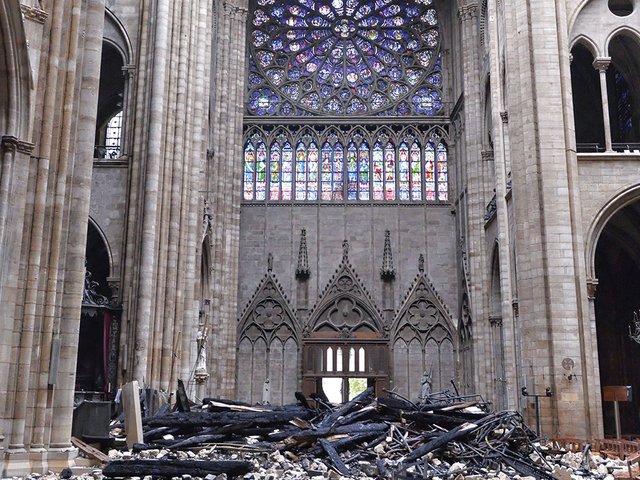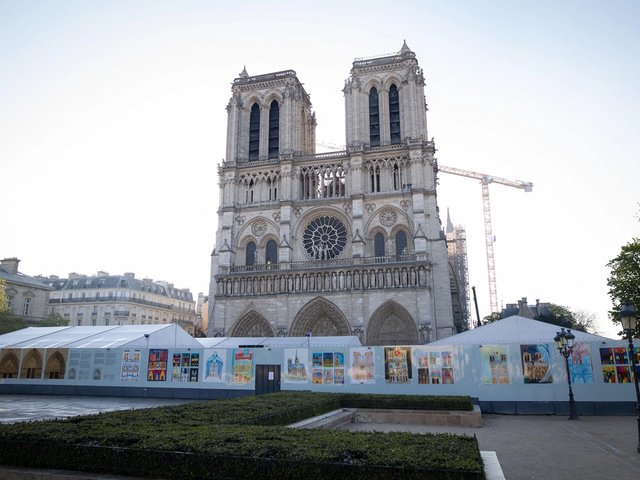The 93-meter spire of Notre Dame cathedral will be rebuilt as it was before the April 2019 fire. The decision, confirmed on Friday by General Jean-Louis Georgelin, who is in charge of the reconstruction, follows months of controversy over the future appearance of the Paris landmark. It is also an abrupt u-turn for President Emmanuel Macron who suggested soon after the fire that the 19th-century spire, which collapsed in the flames, could be replaced by a modern “architectural gesture”.
The proposal triggered wide-ranging protests. Unesco's former cultural head Francesco Bandarin argued that the principles of restoration set down by the Venice Charter must be respected. Some claimed that big sponsors of the restoration such as the founders of LVMH, L’Oréal or Kering companies, and many other anonymous donors, would not be willing to pay for a controversial glass tower. Tensions erupted publicly when the architect in charge of the site, Philippe de Villeneuve, who had expressed his opposition to Macron’s idea, was ordered to “shut his big mouth” by General Georgelin. The government stood firm and last April launched an international architectural competition for a new design.
President Macron’s about-face came one day after the National Heritage Commission recommended “the reestablishment of Viollet-le-Duc’s architecture, using the original materials”, after having examined a 300-page report by the architect in charge. According to a source close to the president, Macron is still not convinced. But he realises that a long architectural competition could threaten plans to reopen the cathedral in time for the Olympic Games in Paris in 2024. The Covid-19 crisis, bad weather and a series of technical incidents have already delayed works for several months. Last summer, the health and safety authority authority ordered a three-week halt to ensure workers’ protection against lead poisoning. The site is still not well guarded. Two drunk thieves were caught looting medieval stones from the cathedral, and last Thursday Greenpeace demonstrators were able to hang a banner calling for “climate action” off an 80m crane.
Two teams of five workers, working in rotation, hanging in the air roped to the crane, have just started to cut the 200 tons of charred and melted scaffolding, which encircled the spire. General Georgelin already admits that the construction will not be completed by 2024, but hopes that the cathedral could be partially open for services.
However, there are still several obstacles that could hinder the reconstruction. The next World Heritage Committee meeting (postponed to a date yet to be announced), which will examine France’s report, along with citizens’ groups and cultural associations, will scrutinise the impact of new plans for the front of the cathedral.
The choice of materials is also controversial. The conservative restoration means that timber and lead will be used for the framework and the roofing, foregoing the opportunity to use safer, more sophisticated modern materials. The use of lead is particularly sensitive because of its toxicity when it contaminates water or air.
The nave and the spire were covered with 460 tons of lead. On Thursday, the American Geophysical Union published a study showing that the exposure to lead in the centre of Paris in the wake of the fire was seriously downplayed. According to its study, almost a ton of lead dust fell to the ground within 1 km of the site, and the concentration of the fallout in this area and downwind was over six times the amount announced by local authorities, which covered a 1-50 km radius, excluding the surrounding of the cathedral. The report also states that the administration should have acted “considerably sooner communicating the hazards”, collecting samples and testing the affected population. Only after seven weeks was it suggested that blood tests be take from the 6,000 children who had been exposed, and then only on a voluntary basis.




